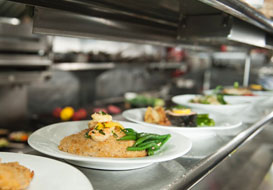The pricing of your food plays a critical role in the success of your hospitality business. It is important to spend the time required to get it right. Manage it on-going to reflect any changes in the business landscape.
If you've avoided an evaluation of your hospitality venue's prices for a long period of time, chances are that you're not as profitable as you could be. Welcome the opportunity to ensure the continued success of your business.
There is no exact formula when it comes to calculating food costs but there is a range of factors you should consider.
If you've avoided an evaluation of your hospitality venue's prices for a long period of time, chances are that you're not as profitable as you could be. Welcome the opportunity to ensure the continued success of your business.
There is no exact formula when it comes to calculating food costs but there is a range of factors you should consider.
1. What are your Cost of Good Sold (COGS)?
How much does it cost to serve each item on your menu? Remember that every cost incurred in running your business has to be covered by the food and drink that you offer.
Let's take the example of producing one hamburger. The costs would include:
That means that before you even consider any other overhead costs you have to charge at least $15.
The cost of producing each item also includes any other expenses directly related to purchasing the food and can include:
Let's take the example of producing one hamburger. The costs would include:
- Patty
- Bun
- Each individual salad item
- Condiments
That means that before you even consider any other overhead costs you have to charge at least $15.
The cost of producing each item also includes any other expenses directly related to purchasing the food and can include:
- Delivery fees
- Interest
- Return charges
2. How much do you spend on overheads?
The costs associated with the day-to-day operation of your hospitality business need to be added to the cost of producing each menu item to get a better picture of the price you should charge.
Wages are a big part of a hospitality business expenses but also consider things like:
As an example:
Depending on your hospitality business this may or may not cater for you target customer. If it doesn't then consider not using as many ingredients or substitute for a cheaper product.
Wages are a big part of a hospitality business expenses but also consider things like:
- Utilities: gas, water, electricity
- Advertising
- Cleaning
- Spoilage
- Theft
- What costs do I incur as I make more sales (variable costs)
- What costs do I incur regardless of whether or not I make a sale (fixed costs)
As an example:
- On average you serve 100 customers per day
- The total cost (variable and fixed not including COGS) to run your business based on serving 100 customers per day is $1000
- This means your daily overhead per person is $10
Depending on your hospitality business this may or may not cater for you target customer. If it doesn't then consider not using as many ingredients or substitute for a cheaper product.
3. How much is your customer willing to pay?
Depending on your target customer, the quality of your food and the dining experience, customers will have a rough idea for the prices you should be charging.
Depending on the hospitality venue that you operate a customer might be willing to pay more or less depending on the following factors:
To increase customer perception of how much you should be charging consider advertising how ingredients are grown, whether it is organic or free-range. Using these words to describe a menu item can often command a premium. So too can items that require more effort, artistry or talent to prepare.
Your business location as well as general supply and demand also play a crucial part in how much you can charge, with these factors being more difficult but not impossible to influence.
Depending on the hospitality venue that you operate a customer might be willing to pay more or less depending on the following factors:
- How often they expect to visit
- How much time they expect to spend in your venue
- How much food they expect to order
To increase customer perception of how much you should be charging consider advertising how ingredients are grown, whether it is organic or free-range. Using these words to describe a menu item can often command a premium. So too can items that require more effort, artistry or talent to prepare.
Your business location as well as general supply and demand also play a crucial part in how much you can charge, with these factors being more difficult but not impossible to influence.
4. What's your competition doing?
Your competition can be a good gauge for how to price your food items. Give some thought though about who it is that constitutes your competition. Consider asking your customers what other businesses they frequent. Make sure that any business you choose to compare your prices with is doing well themselves.
The are a number of different strategies you can employ when pricing yourself against the competition
The are a number of different strategies you can employ when pricing yourself against the competition
- Undercut the competition with the aim of bringing in more business
- Charge more by providing a higher value offering
5. How often do you change your menu? - Seasonality
A good way to keep the cost of your menu items under control is to offer a seasonal menu. Food that is season is usually cheaper to purchase and fresh. This is a win for both you and your customers. By changing your menu items to reflect the season you are forcing yourself to review your pricing on a regular basis.
6. Can you limit the consequences when increasing prices?
It is a fact of life that there will be times when you will have to raise your prices. There a ways of doing this though that will mean you don't lose customers though.
Consider the following tactics:
Consider the following tactics:
- Decrease the portion size of the menu item but keep the price the same
- Create a more attractive name, add a special sauce or theme to the food
- Ensure the more profitable items are given prominence on your menu
- Increase menu items by small increments
7. How can you add to the experience?
Lastly, when it comes to your hospitality business it should be the total value of the experience not just the food that you should reflect in your pricing.
Customers are more likely to judge a restaurant on the quality of your food, the level of customer service and how it is perceived by others before they worry about price.
Finding ways to add more value to the experience of dining at your establishment gives you more leeway when setting menu prices for your hospitality business.
Customers are more likely to judge a restaurant on the quality of your food, the level of customer service and how it is perceived by others before they worry about price.
Finding ways to add more value to the experience of dining at your establishment gives you more leeway when setting menu prices for your hospitality business.


 RSS Feed
RSS Feed